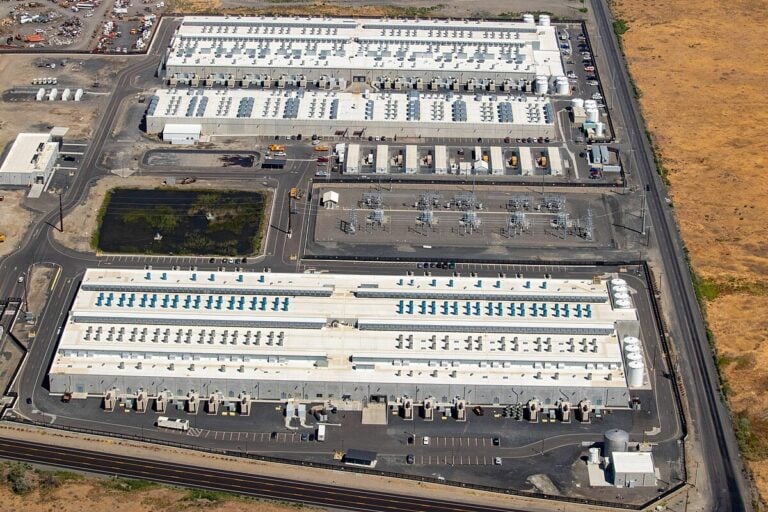Despite this, the magnitude of the task is poised to increase as the rapid development of hyperscale data centres adds significantly to power demand in the US. To mitigate grid disruption from exploding load growth, storage systems could start to take centre stage in the country’s energy transition.
Data centre demand: More generation needed, more quickly
According to the Electric Power Research Institute, data centres are expected to make up 9% of the power demand in the US in five years’ time—double their share today. It is now well documented that AI-assisted internet search queries rely on ten times more electricity than traditional internet searches. To facilitate the development of generative AI to improve these services, the demand for more data centre capacity is growing larger and larger.
When we spoke to Dr. Marco Terruzin, Chief Commercial and Product Officer at global energy storage company Energy Vault, for our Battery + Storage podcast, he noted that, throughout the previous 15 years, energy efficiency gains in the US have been able to keep pace with and contain the growth of load.
By contrast, the additional gigawatt of power demanded by hyperscale data centres cannot be managed through energy efficiency alone. As a result, developers need to consider alternative solutions to secure a continuous operational load.
The 2.7% jump in data centre power demand from 19GW to 21GW in the last year is part of an exponential trend that FERC staff predict will rise to 35GW by 2030.
A factor that compounds the pressure on utilities to deliver more energy is that data centres depend on 24/7 energy connection with layers of backup power in case of a shortage. As such, the intermittent supply of traditional renewable technologies, such as wind and solar, is insufficient alone to meet the scale of rising demands.
This isn’t simply a case of increasing renewable energy generation productivity to meet demand due to the dispatchability issue. Moreover, the positive impact of new capacity is contingent on an efficient grid system that can handle interconnection for additional renewables.
Grid infrastructure in the US is widely regarded to be in a period where significant investment will be required to replace or upgrade aging grid components, to say nothing of the need for altogether new high-capacity lines. US interconnection queues grew 30% longer in 2023.
It is this combination of needing more generation more quickly (and more reliably) that Anza Renewables CEO, Mike Hall, pointed out to us in another podcast episode as the single biggest issue facing the grid. The US is on the precipice of a power crisis, he says.
Energy storage projects and the constant provision of dispatchable clean power hold the key.
Energy storage’s crucial role in the US energy transition
Energy storage could be critical for grid stabilisation as the US ramps up its energy transition programme. Although this will undoubtedly throw up difficulties, the expected boom in data centre construction actually represents a prime opportunity to develop and hone the energy storage sector in concert with hyperscalers’ future targets.
The record installation of battery energy storage systems (BESS) in the US in 2023 (8.4GW) was bettered in 2024 with the addition of 9.2GW by the end of November last year.
BESS projects have become viable as mainstream solutions to energy infrastructure needs and there’s growing appetite to invest in BESS with greater confidence in a return of value.
Can energy storage really keep pace with the data boom? The critical challenges to address from a technical standpoint are:
- Energy density – for lithium batteries in particular, lots of space is required to reserve the necessary amount of energy for backup operational power. Energy storage systems co-located with data centres need to be able to function effectively in more confined surroundings. Innovation is a must and one solution that developers are exploring with optimism is the vertical stacking of storage containers to make the most of limited floor space.
- Degradation – energy storage systems accumulate wear and tear over time. This is a particular problem for lithium-ion batteries, which retain decreasing amounts of energy in recharge, because developers must then have long-term plans to either replace lost capacity at additional expense or allow extra space for overcapacity in the first instance. The development of alternative energy storage systems, such as gravity, hydrogen, or some other alternative battery chemistry will be crucial to offer to developers who cannot allocate more space or finance to replace degraded assets.
- Battery market transparency – although most data centres will have similar requirements of their energy storage projects, there is not one scalable solution that fits every use case. Despite this, there is little transparency for buyers and plenty of competition for vendors in the battery market, making it difficult for developers to make informed decisions about vendor selection and project construction strategy. To keep pace with data centre demand, the energy storage sector must focus on perfecting battery chemistries that are tailored to data centre operations and on securing sustainable supply chains that meet domestic content requirements and ESG considerations.
Speaking with Energy Vault’s Dr. Marco Terruzin, it is clear that if we can get these factors right, we can begin to look at the data centre boom not as a looming power crisis for the US grid, but rather as an important driver of energy storage development that ultimately benefits the energy transition.
About the Author
As a partner in law firm Troutman Pepper Locke’s energy practice, Wiliam Derasmo brings over two decades of experience representing energy companies before the Federal Energy Regulatory Commission (FERC) and state commissions, navigating complex regulatory landscapes and crafting innovative legal strategies for his clients. In addition to his FERC-related work, Bill is engaged with legal issues concerning energy storage and hosts Troutman Pepper Locke’s Battery and Storage podcast.

